A Guide to Product Development Process Steps
Unlock the key product development process steps that turn great ideas into market successes. A practical guide for innovators and product managers.
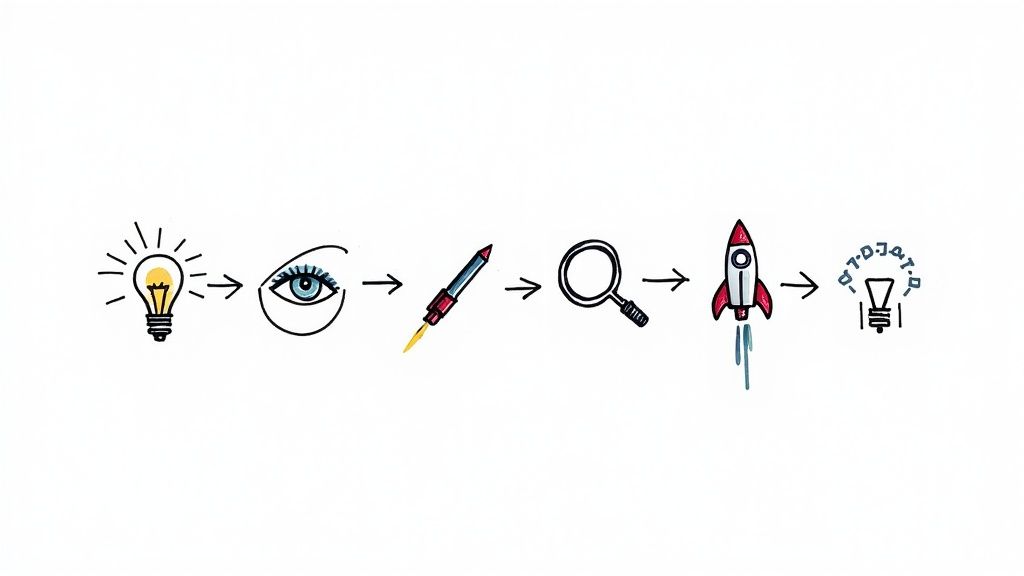
Every great product begins with a simple spark of an idea. But let's be honest, the real work isn't just having the idea—it's turning that initial thought into a solid, workable strategy. The product development process is the roadmap that guides your concept from a "what if" moment all the way to a market-ready launch, making sure it actually solves a customer problem and supports your business.
This journey is all about generating ideas, putting them through the wringer to see if they hold up, and then building a strategic foundation around the ones that do.
From Initial Spark to Viable Strategy
The start of any new product is a whirlwind of excitement and, frankly, a bit of chaos. Ideas pop up everywhere. You might find one buried in a customer support ticket, notice a glaring gap in what a competitor offers, or stumble upon it during a team brainstorming session.
The trick isn't just to collect these ideas but to build a system that can actually capture and evaluate them properly. What you do here sets the stage for the entire product lifecycle. Top-tier companies don't just sit around waiting for lightning to strike; they hunt for it. They'll run internal innovation contests, meticulously analyze customer feedback, or dive deep into market research. It's about moving from random brainstorming to a repeatable process for finding gold.
Filtering Ideas With a Practical Framework
Once you've got a pipeline of ideas, the next step is absolutely critical: screening. Not every idea is a winner, and a good filtering process is what stops your team from pouring time and money into concepts that are dead on arrival. A solid screening framework will test each idea against a few core questions.
- Market Alignment: Does this solve a real, nagging problem for a clearly defined group of people?
- Technical Feasibility: Can we actually build this thing with the team and tech we have right now?
- Strategic Fit: Does this idea line up with our company's long-term vision and what our brand stands for?
This is where you separate the wishful thinking from the genuinely promising concepts.
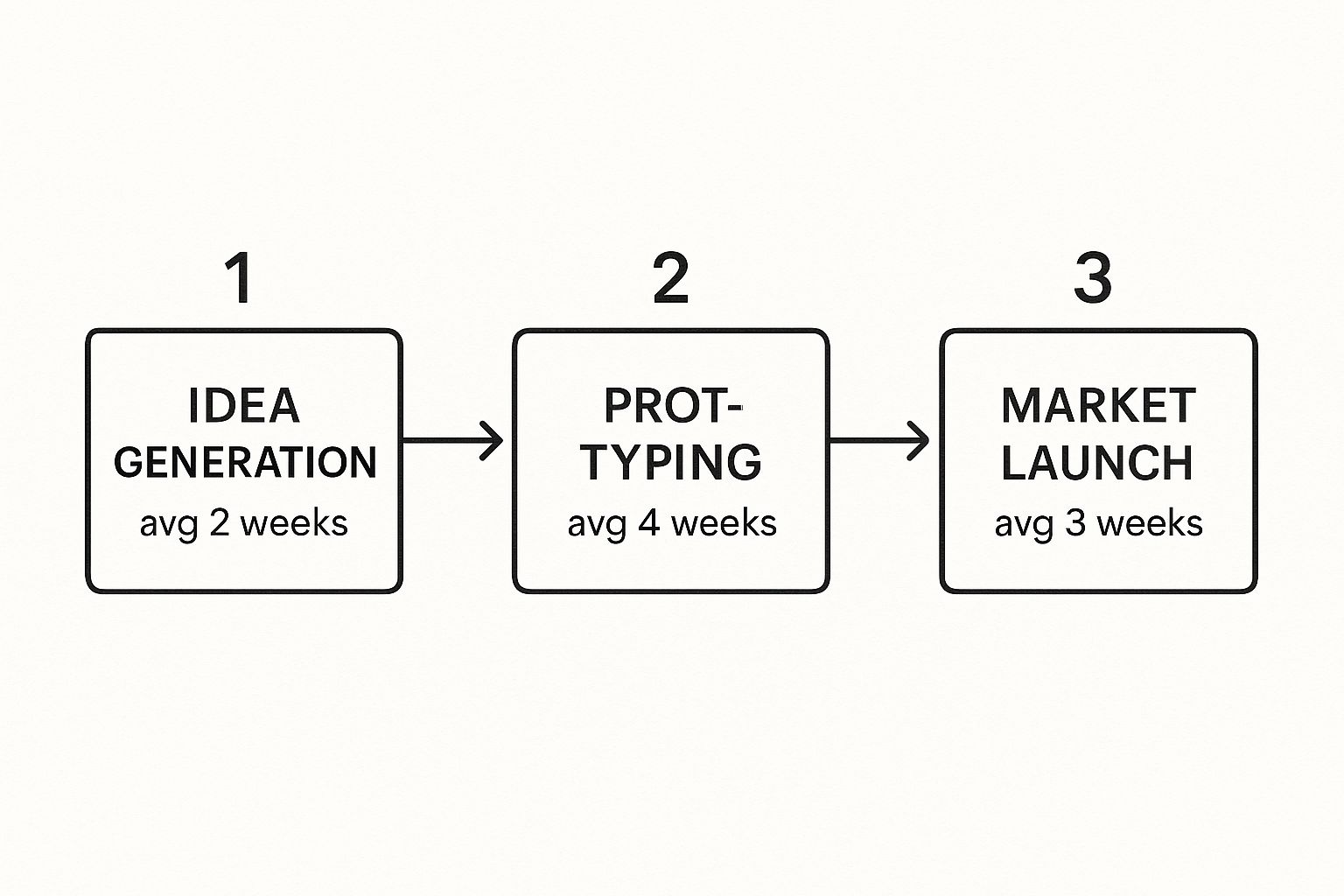
As you can see, coming up with ideas is the easy part. The heavy lifting happens during prototyping, which really drives home why you need to validate your concepts before you start sinking serious development hours into them.
A well-defined screening process is your first line of defense against scope creep and wasted effort. It gives you the confidence to say "not now" to ideas that would drain resources, so you can focus only on those with the highest potential for success.
A classic framework for this is the New Product Development (NPD) process, which breaks the entire journey into clear, manageable stages. This structured approach is a lifesaver in industries like automotive and hardware, where it helps manage risk and ensures every product hits strict quality standards before it ever sees a factory floor. This early strategic thinking is also foundational to creating a great user experience, a topic we cover in our guide on user experience design best practices.
Validating Your Vision With Real-World Feedback
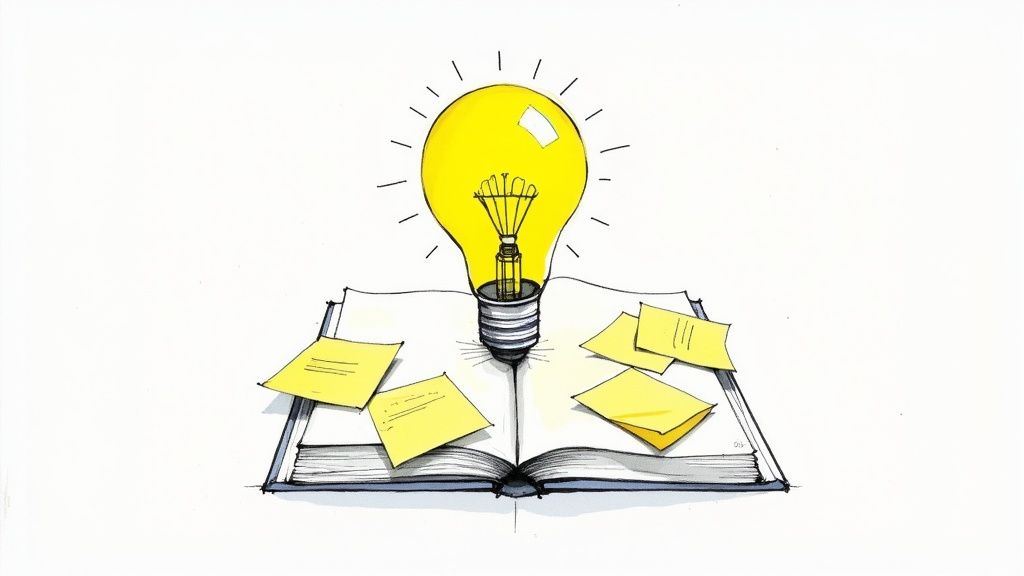
An idea is just an idea until you can prove people actually want it and the numbers make sense. This is the stage where you stop talking about features and start defining a clear value proposition. It’s all about building a solid case for your product, backed by real-world feedback, not just your own excitement.
The first move is to create something tangible that brings your vision to life. This doesn't mean you jump into coding. Not yet. Instead, you'll focus on things like user flows, wireframes, and basic mockups.
Imagine you're designing a new project management tool. You'd start by mapping out the entire user journey—from the moment someone creates a task to when they mark it complete—visualizing every single screen along that path. These early designs, often built with simple icons and layouts, are your first chance to pull the concept out of your head and put it into a format others can actually interact with.
Turning Concepts Into Testable Prototypes
With your visual mockups ready, it's time to get them in front of real people. This is where user interviews and prototype testing come in, and frankly, it's one of the most important product development process steps you can take. It’s here that you validate your core assumptions before you sink too much time and money into the project.
You’re not just asking, “So, do you like it?” The real question is, “Does this actually solve a problem for you?”
To get this right, effective prototype testing should include:
- Finding the right people: Don’t just grab friends and colleagues. You need to recruit users who genuinely fit your ideal customer profile.
- Watching what they do: Observe how people interact with your mockups. Pay close attention to where they hesitate, get stuck, or seem surprised.
- Asking better questions: Avoid leading the witness. Instead of "Clicking here takes you to the dashboard, right?" ask, "What would you expect to happen if you clicked that button?"
This feedback loop is priceless. It helps you spot fundamental design flaws and confusing workflows early on, saving you from a world of hurt and countless hours of rework down the road.
A validated concept is more than a good idea; it's an idea that has survived its first contact with reality. This is where you confirm that your solution truly resonates with the target audience and addresses their specific pain points.
Building a Realistic Business Case
Okay, so you have evidence that people want what you're building. Now you have to prove it can actually be a viable business.
You don't need a hundred-page financial model at this point. Keep it simple. While a full lifecycle analysis might uncover up to 20 critical steps, your focus right now is on a few key numbers. Setting SMART goals here is crucial for staying on track. If you're interested in the bigger picture, you can learn about all the critical product development steps on dashdevs.com.
Start by estimating your main costs. Then, figure out a clear pricing strategy based on the value you're delivering. From there, you can put together a rough revenue forecast. The goal isn't perfect accuracy—it's about creating a realistic projection that gives stakeholders the confidence to invest. This business case is what turns your validated vision into a plan worth backing.
To help break this down, here’s a quick look at the core activities involved in validating your product idea.
Core Activities in Product Validation
| Stage | Key Activities | Example Tools | Primary Goal |
|---|---|---|---|
| Concept Development | User journey mapping, wireframing, creating mockups, lo-fi prototyping. | Figma, Sketch, pen and paper. | Visualize the core solution and user experience. |
| Business Analysis | Cost estimation, competitor analysis, defining pricing strategy, revenue forecasting. | Spreadsheets (Google Sheets, Excel), market research reports. | Determine if the product is financially viable. |
These two stages work together to ensure your idea isn't just a good one, but a sustainable one. By the end of this phase, you'll have a clear, data-supported reason to move forward.
Bringing Your Product to Life with Design and Prototyping
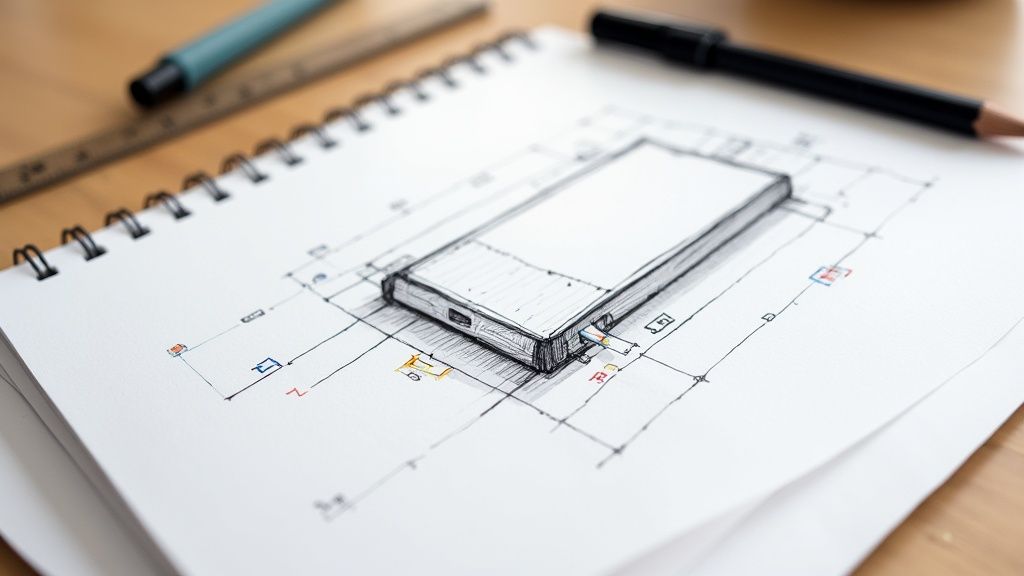
Alright, you've validated your concept and the numbers add up. Now for the fun part: moving your idea from abstract plans into something tangible and interactive. This is where your vision really starts to take shape, turning strategic documents into something users can actually see and click on.
It all starts with design, but I'm not just talking about making things look pretty. The real work begins with low-fidelity wireframes. Think of these as simple, black-and-white blueprints for your product. They're all about structure and flow, mapping out the user's journey and deciding where essential elements like buttons and menus will live, long before you get distracted by colors and fonts.
Once the basic structure feels right, you move on to high-fidelity mockups. These are the full-color, pixel-perfect designs that look and feel like the final product. Here, you'll bring in your brand’s typography, color scheme, and of course, your icons to create a static but highly realistic preview of what's to come.
From Static Mockups to Interactive Prototypes
With your polished mockups in hand, the next move is to make them breathe. Prototyping is what bridges the gap between a static picture and a functional experience. You create clickable models that simulate how the product will actually behave, letting you test out the flow and get real feedback before a single line of code gets written.
Here's the key distinction: a mockup shows what your product looks like, while a prototype shows how it works. This is absolutely critical for early-stage usability testing. Considering that 63% of consumers expect businesses to understand their unique needs, a working prototype is your first real chance to see if you're hitting that mark.
This loop—building a prototype, putting it in front of users, and refining the design based on what you learn—is priceless. It helps you quickly spot a confusing navigation path or an awkward workflow, allowing you to make fixes in a few hours instead of a few weeks. If you're looking for the right tools for the job, our guide on the best vector design software is a great place to start.
This build-test-learn cycle is your best defense against costly rework. Catching a major usability flaw in the design phase is a minor setback; catching it after development is a major financial and resource drain.
The Power of a User-Centric Approach
Throughout this entire stage, your mantra should be "user, user, user." Every single design choice, from the size of a button to the wording on a menu, needs to answer a specific user need or help them achieve a goal.
Here are a few core activities that keep you honest:
- Creating User Personas: Build out detailed profiles of your target users. Giving them names and backstories helps your team design with genuine empathy.
- Mapping User Flows: Whiteboard the step-by-step paths users will take to get things done in your product. This ensures the journey feels logical and friction-free.
- Conducting Usability Testing: The moment of truth. Watch real people interact with your prototype to see where they get stuck, confused, or frustrated.
By relentlessly focusing on the user, you're not just building something that works. You're building something that people find intuitive and genuinely enjoy using, setting the stage for a much smoother development phase.
Finalizing the Product: From Rigorous Testing to a Flawless Launch
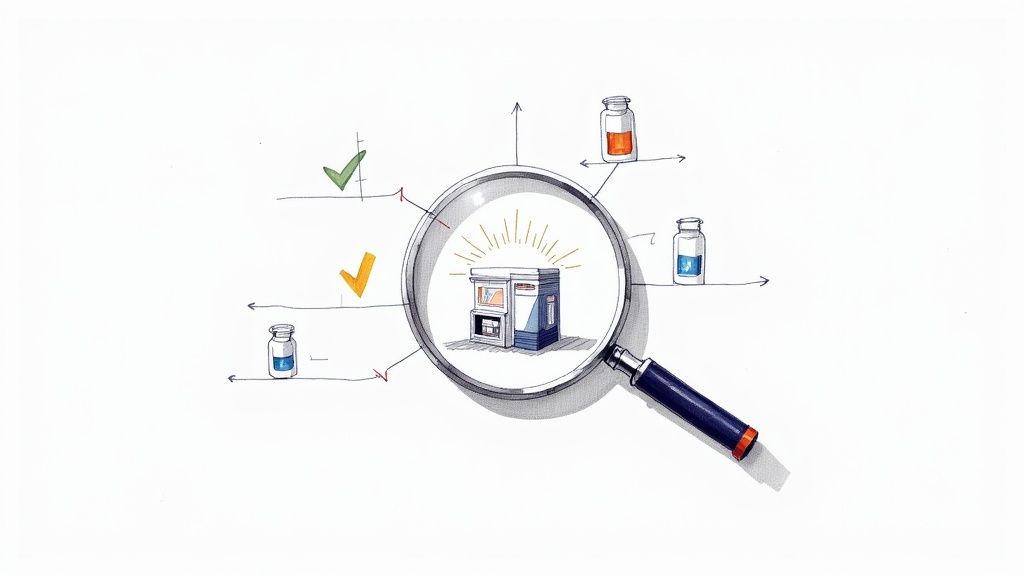
You’ve designed, prototyped, and brought your product to the brink of reality. It's so close you can almost taste it. But this final stretch is what separates a good product from a great one. It's not about just flipping a switch; it's about meticulous, layered testing and a launch so well-coordinated that your entry into the market feels smooth and inevitable, not like a chaotic scramble.
These final product development process steps really break down into two critical parts. First comes the rigorous testing to ensure everything is rock-solid. Then, you need a smart launch plan to build momentum right out of the gate. Trust me, skipping or rushing either of these can unravel all the hard work you've put in so far.
Building a Bulletproof Testing Strategy
Before your product gets anywhere near a real customer, it has to go through a trial by fire. This isn't just a single check-the-box activity. It’s a multi-layered process designed to hunt down every last bug, pinpoint usability headaches, and confirm your product is truly ready for the wild.
Think of it as a series of quality gates, each one more demanding than the last. Your testing funnel should look something like this:
- Internal QA Checks: This is your first line of defense. Your quality assurance team systematically works through the product, stress-testing every feature and actively trying to break things. Their job is to find the problems before anyone else does.
- Alpha Testing: Next, you hand it over to a small, trusted group of internal users—maybe people from different departments. They use the product in a more natural, real-world context, which helps catch issues that crop up during day-to-day use, not just in scripted tests.
- Beta Programs: Finally, you release the product to a select group of external users. Their feedback is pure gold. It tells you how your product actually performs out in the world and whether it solves the problems you set out to fix.
A thorough testing phase is non-negotiable. It’s the last barrier protecting your customer's experience, and it directly impacts their trust and willingness to stick around. A buggy launch is an uphill battle you don't want to fight.
Crafting Your Go-to-Market Plan
Once testing confirms your product is stable, the focus shifts to the launch. A successful go-to-market (GTM) strategy is less of a marketing checklist and more of a coordinated symphony. It's about getting your sales, marketing, and support teams all singing from the same hymn sheet to create a powerful wave of initial adoption.
This push for speed is everywhere in modern development. In fact, a recent industry survey found that 62% of teams feel pressured to shorten their turnaround times simply because of consumer demand. On top of that, 65% are speeding up their cycles just to keep up with the competition. This highlights just how crucial an efficient, well-planned launch really is. You can get more information about the push for faster product development on brex.com if you want to dig into the data.
To get it right, your GTM plan needs to nail a few essentials. You need crystal-clear product positioning that screams your unique value from the rooftops. You also need a well-defined pricing strategy that makes sense for the value you're offering. Finally, a drumbeat of promotional activities—from content marketing to launch-day announcements—will generate the buzz you need to lift off.
Managing Your Product After the Launch
Getting your product out the door isn't the finish line—it's the starting gun. The real race begins now. Your mindset has to shift from a project-based sprint to a long-term marathon of continuous improvement. Markets are dynamic, and your product needs to adapt to stay in the game.
This next phase is driven entirely by data. Your success hinges on how well you can build systems to collect, analyze, and act on insights from three critical sources: real user feedback, hard performance metrics, and what your competitors are doing. This information is the fuel for your product's evolution.
Creating a Powerful Feedback Loop
Your absolute first priority is to build a direct channel from your customers' mouths to your development backlog. Don't just sit back and hope people will tell you what they think; you have to go out and ask for it.
Here are a few practical ways to get the conversation started:
- In-app surveys: Pop up a quick, targeted question at a key moment, like after a user completes a task for the first time.
- Customer interviews: Nothing beats a real conversation. Schedule regular calls with both your power users and the folks who just signed up.
- Support ticket analysis: Your support channels are a goldmine. Dig through tickets to spot recurring frustrations and common pain points.
The idea isn't just to collect a mountain of comments. You need to structure it. Start grouping similar requests, tagging them by theme like "usability" or "new feature request," and then try to quantify their potential impact. This process turns a chaotic flood of opinions into a clear, prioritized list of things you can actually work on.
Your product is no longer just your vision; it's a living entity shaped by the people who use it every day. Listening to them is the single most effective way to guide your post-launch strategy.
Prioritizing Your Next Moves
Once you have a steady stream of feedback and performance data flowing in, the real challenge begins: what do you work on next? You can't build everything, so you need a smart way to prioritize. A great starting point is to sort tasks into three main buckets: bug fixes, feature requests, and bigger strategic updates.
For example, a critical bug crashing the app for 10% of users? That jumps straight to the top of the list, no questions asked. After that, it gets trickier. You might have to weigh a small, highly-requested feature against a larger update that aligns with your six-month roadmap. It’s a constant balancing act between keeping your current users happy and pushing the product forward.
Maintaining consistency through all these updates is key, which is where having your brand assets in order really helps. You can dive deeper into this with our guide on brand asset management solutions. This is the very essence of managing the final product development process steps: iterate, learn, and improve.
Your Top Product Development Questions, Answered
Even with a perfect plan on paper, the road of product development is full of twists and turns. It's only natural for questions to pop up. Over the years, I've seen teams run into the same challenges and ask the same questions, whether it’s their first go-around or they’re seasoned pros.
Let’s tackle some of the most common ones right now. Getting clear on these points helps get everyone on the same page and keeps the project running smoothly.
What’s the Most Important Stage in the Product Development Process?
Every stage matters, but if you forced me to pick one, I'd bet everything on the very beginning. The initial idea screening and concept validation stages carry an incredible amount of weight, setting the direction for everything that comes after.
Nailing this early part is your best defense against a classic, painful scenario: building a beautiful, flawless product that nobody actually uses. It's a shocking statistic, but research from Harvard Business School points out that the vast majority of the 30,000 new products launched each year don't make it. The number one killer? A total disconnect with what the market actually needs—a problem that solid, early-stage validation is meant to solve.
A strong foundation built on proven market demand and clear business viability dramatically increases the odds of success. Rushing through validation to get to the "building" phase is a recipe for wasted time, money, and morale.
Think about it this way: fixing a bad idea on a whiteboard is cheap. Fixing a bad product after you've sunk months of development and thousands of dollars into it? That’s a nightmare.
How Long Does the Product Development Process Typically Take?
Ah, the classic "it depends" question. And honestly, it's the only real answer. There's no magic number here because the timeline is a unique mix of factors that change from one project to the next.
For example, a simple new feature for an existing app might be designed, built, and shipped in a couple of months. On the flip side, something complex like a new electric vehicle could easily take several years when you factor in all the engineering, supply chain logistics, and regulatory hoops you have to jump through.
A few key things that will stretch or shrink your timeline:
- Product Complexity: Is it a minor tweak or a brand-new platform built from the ground up? The difference is massive.
- Industry Regulations: If you're working in an area like fintech or healthcare, get ready for a longer haul. Compliance adds significant time.
- Team Size and Resources: A small team juggling multiple projects will move slower than a larger team dedicated to one thing. Simple as that.
- Development Methodology: An Agile approach, with its focus on iterative sprints, can get an MVP out the door much faster, even if the grand vision takes longer to complete.
What Are the Key Roles on a Product Development Team?
Great products are never built in a vacuum. They're the result of a team sport, where people with very different skills come together and collaborate. While the exact titles might change, a solid product team is almost always a cross-functional group.
Here's a look at the core players:
- Product Manager: This person is the strategic guide. They own the product vision, decide what gets built next, and keep the lines of communication open between everyone else.
- UX/UI Designers: They are the voice of the user. They do the research, map out user flows, build prototypes, and make sure the final product feels intuitive and looks great.
- Engineers/Developers: These are the builders. They take the designs and ideas and turn them into a real, working product. They write the code, manage the tech, and figure out how to overcome technical hurdles.
- Quality Assurance (QA) Testers: They are the champions of quality. Their job is to find bugs, spot performance issues, and generally try to break things so that your users don't have to.
In bigger companies, you'll often see this core group supported by Project Managers, Product Marketing Managers, and data analysts, who all add another layer of coordination and insight.
How Can We Reduce the Risk of Product Failure?
Trying to eliminate risk is a fool's errand. The real secret is to manage it by embracing a culture of continuous validation. You want to make a series of small, smart bets and learn from them quickly, instead of one giant, risky leap of faith.
The single best way to do this? Create a tight feedback loop with your target users from day one. Don't just build in a dark room—get out and talk to people. Create cheap, low-fidelity prototypes to test your core assumptions long before you write a single line of code.
This is also where launching a Minimum Viable Product (MVP) becomes such a powerful tool. An MVP isn't your final product; it's a vehicle for learning. It lets you test your main idea with actual users in the real world, giving you priceless data on what's working and what isn't. This iterative, feedback-first approach is so much less risky than a big-bang launch based on nothing but assumptions.
Ready to bring your product vision to life with stunning, consistent visuals? VibeIcons helps you create the perfect AI-generated icons to match your brand and streamline your design workflow. Generate your first five icons for free at https://www.vibe-icons.com and see the difference for yourself.